An underwater treadmill for dogs can be a great way to help a dog rehabilitate from an injury, build strength and mobility, and reduce pain. Plus, most dogs really enjoy it (even the ones who don’t normally love water)! Integrative veterinarian Dr. Julie Buzby invites her friend and fellow veterinarian, Dr. Jessica Harris, to share more about the use and benefits of underwater treadmills for dogs.
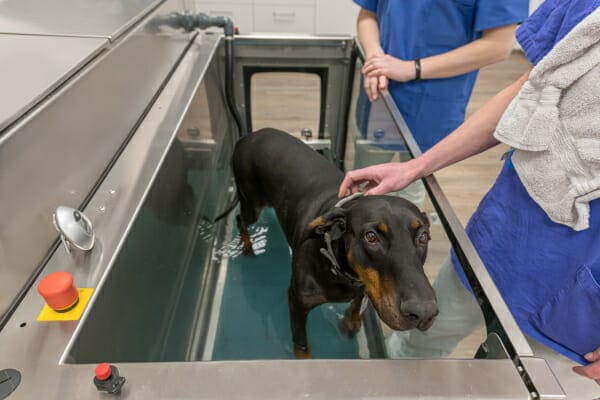
When I was working in a specialty animal hospital, I met Cooper. He was an 8-year-old retired German Shepherd police dog who now lived with his handler’s family. Cooper visited me for an appointment shortly after his retirement started. A few months prior, Cooper had suffered from a gunshot injury to his right shoulder.
Initially, Cooper seemed to be on the right path to complete recovery after his injury. However, he had started to show increased weakness in that shoulder and wasn’t moving it as much when he walked. He even dragged his foot sometimes. Also, Cooper’s dad said it seemed like since Cooper’s gunshot wound, Cooper had started to develop more signs of arthritis in his hips.
Finding a solution for Cooper’s mobility issues
No matter how many different medications they tried, nothing seemed to help much. I told Cooper’s dad that an integrative medicine approach is often a great fit for cases like his. Sometimes, non-traditional medicine can provide benefits that medications simply can’t.
After analyzing Cooper’s gait, it was evident that he barely put weight on his injured shoulder. Cooper’s muscles around his shoulder were obviously weak and were preventing him from properly using his leg.

I suggested that we try to strengthen some of Cooper’s shoulder muscles. This would allow Cooper to shift his weight in a more appropriate and normal fashion when walking. The hope was that if he could return to a more normal gait, this would help take some of the pressure off the joints in his hind legs where he was developing arthritis. Cooper’s dad was excited to try anything new that might help.
I suggested that we start Cooper’s treatment plan with the underwater treadmill. But before we began, I took time to discuss the benefits and expectations for underwater treadmill therapy with Cooper’s dad, much like I am about to do here.
What is an underwater treadmill?
I started off by asking Cooper’s dad, “Have you ever used a treadmill at the gym or physical therapist?” He had, so he understood that when you stand on the treadmill, the floor moves beneath you like a conveyer belt, encouraging you to start walking. I went on to explain that an underwater treadmill for dogs works very similarly. However, the conveyer belt the dog is walking on is under water.
As such, the construction of an underwater treadmill is a bit different than the treadmills you would use in a gym. Most underwater treadmills are built like an aboveground pool. They are usually rectangular-shaped boxes with glass or plastic watertight walls on all sides. The floor of the box is the treadmill portion.
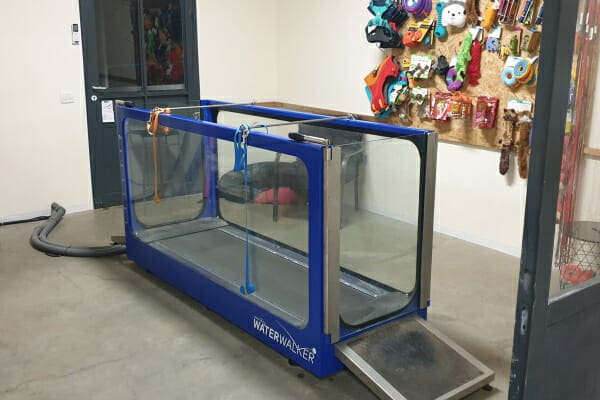
The dog walks into the underwater treadmill “box” and someone shuts the watertight door behind him or her. Then after the dog is secure, the water fills the treadmill, usually from the ground up. This allows the dog to slowly adjust to the increasing water level.
What should I expect during my dog’s underwater treadmill session?
Using the canine underwater treadmill requires some specific set up. First, many dogs will wear a harness or life jacket in the treadmill, at least for their first few treatments. This harness provides a way for the veterinary team to help encourage your dog to walk forward with the correct motion. Depending on the reason your dog is using the treadmill, it also can help the veterinary team support your dog’s weight appropriately.
Once the dog is wearing the harness or life jacket (if needed), the veterinary team will load the dog into the treadmill. Often, dogs who are first-time users or who are weaker due to an injury or surgery will have a person in the treadmill with them. This person helps keep the dog moving appropriately. The term for this is “patterning.” It is that person’s job to ensure that the dog is trying to move his or her legs in a normal gait pattern and is placing his or her feet as normally as possible.
Not every dog will need someone to help them, and some dogs only need help during the first few treatments.

Adding the water
After the veterinary team decides if someone needs to be in the treadmill with your dog or not, they will begin to add the water. They usually do this very slowly to allow your dog time to adjust and process what is happening. While adding the water, the treadmill portion is usually moving to encourage your dog to start walking.
The level of the water will vary with every dog and every injury. In most cases, the water needs to be slightly above the injured or weakened area. This will help ensure the affected area is working against the resistance of the water, not the air.
Regardless of the injury, the water typically does not go above a dog’s shoulders. This is so he or she doesn’t have to get his or her head wet.
Starting the exercises
Once the water has reached the desired level, the veterinary team will set the treadmill to the speed your vet suggests. Usually the speed is set fairly slow. This is because the most important part of the treadmill therapy is working against the water to develop strength and practicing placing feet and legs in the appropriate, normal positions.
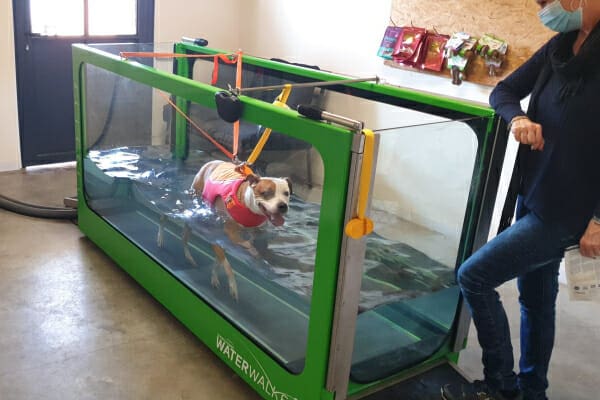
Depending on how well your dog is appropriately placing the feet and responding to cues from the veterinary team, it is possible that the team may add “bumpers” to the treadmill. These bumpers may be pool noodles, rubber floaties, or other items. Their purpose is to help keep your dog in the center of the treadmill and walking in a straight line.
Determining therapy duration
Every dog’s therapy session will be different. The veterinarian will create a plan specific to your dog’s needs. Often, initial therapy sessions will be shorter, at slower speeds, and with more water.
After a few sessions, it is possible that the session will increase in duration, increase in speed, or decrease in water level. The idea is to start the exercises out slow and easy. Then the veterinary team will work up to more difficult exercises as your dog’s strength increases and his or her injury heals.
Your dog’s injury or condition and the accessibility of the underwater treadmill will also determine the number of sessions. Dogs who are building muscle after physical injuries typically need fewer sessions than dogs who suffer from nerve damage.
Also, there are some dog parents who choose to continue underwater treadmill treatments for the rest of the dog’s life. This might be the case with dogs who are arthritic. It is also true for our beloved senior dogs who get weaker with age.
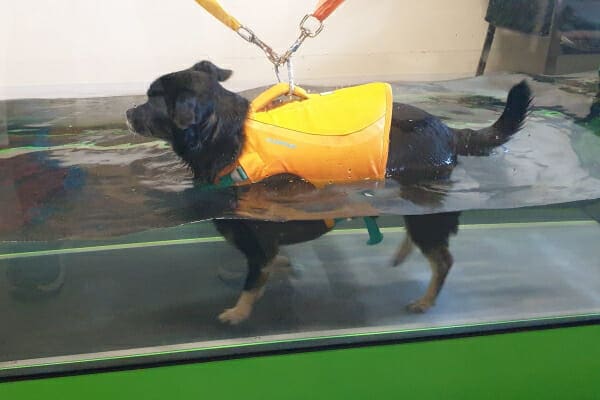
What if my dog doesn’t like water or is nervous in new situations?
The good news is that your dog does not have to be the dog who usually leaps into the ocean to go swimming in order to be a good candidate for the underwater treadmill. Most dogs (and even cats) adjust to the treadmill very quickly and don’t act afraid of it. The most important part of using an underwater treadmill is to offer rewards and reassurance!
Many dogs love using the treadmill because they quickly learn it means they get a special treat or toy while they are doing their exercise. Also, they usually get lots of attention from the people who are making sure they are walking appropriately. Because of all this, even dogs who don’t like the water typically do very well in the underwater treadmill.
What are the advantages of using an underwater treadmill?
Using an underwater treadmill is a form of hydrotherapy. This term simply means “the therapeutic use of water.” Aquatic therapy has been popular in human medicine and exercise for a long time. On the animal side, horse racing was the first place hydrotherapy was used for healing and conditioning. Shortly after that, hydrotherapy for dogs began to increase in popularity.
The biggest benefit of hydrotherapy is the buoyancy and resistance of the water. This allows dogs (or humans or horses) to exercise and condition their body with less stress on their joints than they would experience walking on land. As a result, injured dogs can work their muscles more, and with less pain and stress, than they could on a normal walk.
Another benefit is that the water in the underwater treadmill is usually fairly warm. The warm water temperature also helps to relax joints and ease pain, just like sitting in a hot tub would do for you or me.
Which dogs can benefit from using an underwater treadmill?
Almost any dog can benefit from participating in hydrotherapy! It is a safe and effective way of exercising and conditioning with very minimal risks.
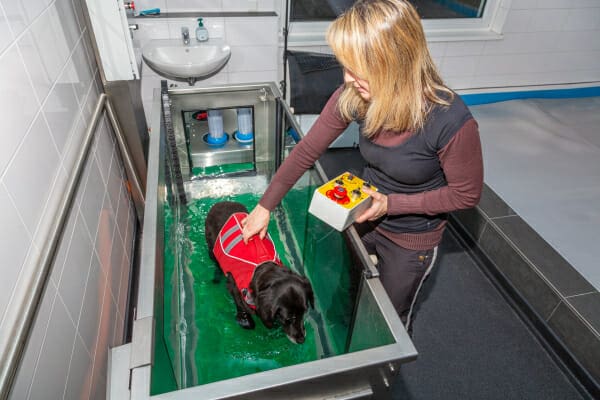
However, there are specific categories of dogs who tend to be typical hydrotherapy patients. Some training centers for agility or sport dogs will have an underwater treadmill. As mentioned previously, exercising in water is one of the most effective and safe ways to develop muscle tone, which is especially important for these doggie athletes.
On the veterinary side, hydrotherapy is most commonly recommended for dogs who have suffered from a bone, joint, muscle, ligament, or nerve injury. Using an underwater treadmill for these dogs is one of the most efficient ways to help them regain strength and normal function.
Your veterinarian might recommend using an underwater treadmill if your dog has any of the following conditions:
- Ligament laxity
- History of a broken bone
- Osteoarthritis in dogs
- Hip dysplasia in dogs
- Torn ACL in dogs (cranial cruciate ligament tears)
- Intervertebral disc disease (IVDD in dogs)
- Strained muscle or muscle loss
- Decreased range of motion (also check out the article Passive Range of Motion Exercises for Senior Dogs for more exercise ideas)
- Recent amputation (i.e. Tripawd dogs)
- Difficulty with weight management (in conjunction with the tips in Dr. Buzby’s article, How to Help a Dog Lose Weight)
These are only some of the most common conditions where the underwater treadmill may be beneficial as part of the treatment plan. If you have any questions about whether your dog would be a good candidate for hydrotherapy, please discuss it further with your veterinarian.
Are there any conditions where a dog should not use an underwater treadmill?
In general, underwater treadmills are very safe and effective. However, there are some instances where dogs may need to wait a bit before they start hydrotherapy. Often this is because they should not be getting wet.
For example, dogs who recently had surgery should wait until their incisions have healed and their veterinarian clears them for baths and swimming. This is important because many sutures dissolve over time. If they get wet, this could cause them to dissolve faster. Then the incision could open and become infected.
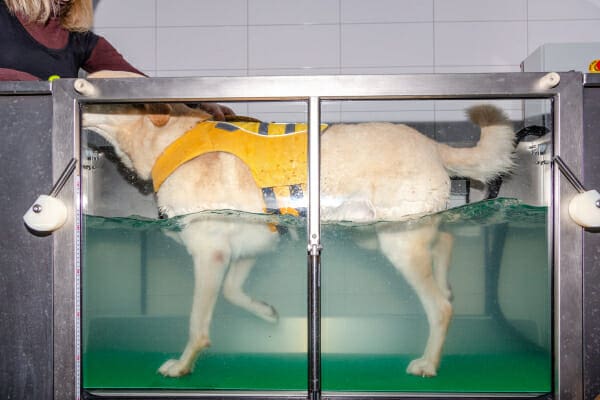
Also, dogs who have casts will most likely need to wait on hydrotherapy as well. Casts can become damaged in water. Or if there is moisture trapped inside the cast, the dog could develop a skin infection under the cast.
Additionally, dogs who have active skin infections or open wounds should wait until their injuries heal before using an underwater treadmill. This helps ensure the wounds do not become infected or irritated.
Can I take my dog swimming instead of using an underwater treadmill?
Understandably, some dog parents may wonder if swimming makes a good substitute for exercise on an underwater treadmill. However, swimming and underwater treadmills are actually quite different.
An underwater treadmill provides a very controlled and calm environment. Your veterinarian can control the speed your dog is walking and the level of water your dog is walking in. This controlled setting is very important to ensure that your dog is exercising at the appropriate level for his or her healing journey. Far less control is possible with swimming.
Also, in an underwater treadmill, your dog is walking, not swimming. When dogs swim, their leg motions are not as consistent and rhythmic as when they walk. This means that they are more at risk for injury, especially if they are already healing from a previous injury.
Finally, if you take your dog swimming, your dog’s gait and movement is not being closely monitored by a veterinarian like it would be in an underwater treadmill.
Swimming does have its place
But don’t discount swimming entirely. Even though swimming and use of an underwater treadmill are not equivalent, swimming can still be beneficial for some dogs. Swimming is still a great way to use the properties of water to develop strength and muscle tone. It is also lower impact than running or jumping.
However, swimming is better for dogs who are healed from injuries and are ready for more strenuous exercise. Your veterinarian is a great resource to help you know when would be an appropriate time for your dog to swim after healing from an injury.
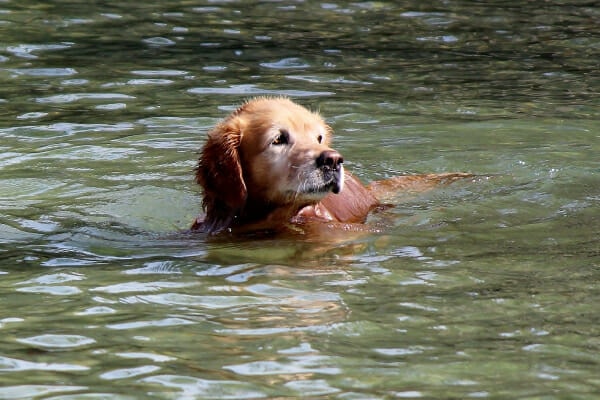
Is there a way to make a DIY underwater treadmill for dogs?
The other question I sometimes get from dog parents is whether they can simulate an underwater treadmill at home. Because of the importance of a controlled environment when using an underwater treadmill, there is not an effective and safe way for owners to create an at-home version. As a result, the best plan is to find a facility with an underwater treadmill.
How do I find a dog underwater treadmill near me?
Due to how large and costly underwater treadmills are, it is very common that most general practitioners will not have one in their office. Underwater treadmills are more common in:
- Specialty hospitals
- Veterinary school teaching hospitals
- Integrative medicine hospitals
- Physical therapy facilities
If you are interested in pursuing hydrotherapy for your dog, please ask your veterinarian for suggestions to find the closest underwater treadmill to you. If it turns out that you live somewhere that doesn’t have access to an underwater treadmill, your veterinarian can also recommend other safe physical therapy exercises that you can perform at home to help your dog heal.
Cooper’s happy ending
Cooper continued hydrotherapy sessions with me for several months. It was amazing to watch him gain strength and confidence as he healed. Also, he loved the underwater treadmill because it meant that he got to hold his special duck toy during his sessions!
As Cooper’s shoulder returned to normal function, we saw his gait improve as well. Because Cooper was using his shoulder to carry more weight, the arthritis in his hips also became less noticeable. Additionally, the underwater treadmill helped relax his joints and ease some of the pain associated with his arthritis.
The underwater treadmill improved Cooper’s quality of life so much that his dad decided to continue to bring him for therapy sessions even after he was completely healed. Cooper loves the exercise and benefits from it too!
If you have a dog who is recovering from an injury, struggling with a chronic musculoskeletal issue, or could benefit from improved muscle mass and mobility, ask your veterinarian if underwater treadmill therapy would be a good option. Perhaps your dog could prosper from it just like Cooper.
Does your dog benefit from an underwater treadmill?
Please share his or her story below.


My 7.5 yr old golden lab has been in PT for several months for a chronically inflamed iliopsosas and they will be getting an underwater treadmill soon. They really seem to think it’s going to help her build strength and heal. We ALL are quite excited to try this!
Hi Patty,
That is such exciting news! I really think you will love it for your girl, and she will enjoy it too. If you have a chance, keep us updated. I’d love to hear about your experience as you pursue this with your dog.
Our dog uses an under water treadmill now for degenerative myelopath & quite a bit of bridging of her vertebrae . She’s a 14 y/o shepherd/lab mix. The water therapy helps avoid muscle atrophy in her back legs. She knuckles & drags her left rear leg so we’re hoping to slow down the progression by using the underwater treadmill along w/ laser therapy. I think she enjoys the food treats she gets as incentive to keep walking on the treadmill ?
Hi Joan,
Thank you for sharing your experience with us. I am glad your girl enjoys her therapy sessions. I love food motivated dogs! I pray you have many more days to love on her and make memories. Best wishes to you both. ♥
We are actually taking our senior dog this Monday for an evaluation to a facility that has hydrotherapy and other options . This article is very timely for me and very helpful. Thanks!
Hi Lisa,
I am glad you found the article to be helpful. I wish you and your dog the best. Good luck at the new rehab facility!
Thank you for the wonderful information! I rescued a former puppy-mill dog who wasn’t able to walk so I started him on CBD and cold-laser therapy and will definitely check into this as well.
I have a very active 7 month old Rottweiler. We found a self dog wash business that offers underwater therapy, grooming by them or by the pet owners. Dakota absolutely loves the treatments. We go everyday to help with any built up energy that we haven’t burned off in our other activities. Good luck to everyone
Hi Yvonne,
I am so glad Dakota loves the time in the water and it is helping to expend extra energy. Thank you for sharing your experience with us. Best wishes to you and your sweet pup!